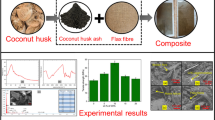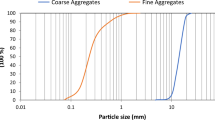Abstract
The reduction in weight, increase in stiffness and increase in strength of a metal matrix composite (MMC) connecting rod when compared to the conventional steel connecting rod have motivated researchers in this area in recent times, but the current cost to produce a metal matrix connecting rod still makes this technology unfeasible for mass production. Because of this most research in this area is producing MMCs using low cast agro-waste as reinforcement. This opens a new window for the present work which is the actual performance analysis of the developed connecting rod using Al-Cu-Mg/4 wt.% bean pod ash (BPA) nanoparticles using a Toyota Carina one(1) model engine. The fuel consumption, induced stress, brake load and power were evaluated. The results were compared with a standard connecting rod. The fuel consumption of the developed MMC connecting rod (0.350 to 0.650 kW/h) was lower when compared to the standard connecting rod (0.430 to 0.761 kW/h) which results in to 0.36 % savings. The stress induced in the developed connecting rod was lower than that of the standard connecting rod. This work has established that using a connecting rod with Al-Cu-Mg/bean pod ash nanoparticles results in to good strength, reduced weight and induced stress with fuel saving of 0.36 %.
Similar content being viewed by others
References
Goenka PK, Oh KP (1986) An optimum connecting rod design study? A lubrication viewpoint. J of Tribology, Transactions of ASME 108:1234–1239
Folgar F, Wldrig JE, Hunt JW (1987) Design, fabrication and performance of fiber FP/metal matrix composite connecting rods. SAE Technical Paper Series 1987, Paper, vol 870406
Athavale S, Sajanpawar PR (1991) Studies on some modelling aspects in the finite element analysis of small gasoline engine components. In: Small Engine Technology Conference Proceedings, Society of Automotive Engineers of Japan, Tokyo, pp 379–389
Vegi VG, Vegi LK (2013) Design and analysis of connecting rod using forged steel. International Journal of Scientific & Engineering Research 4(6):678–683. June 2
Prakash Om, Gupta V, Mittal V (2013) Optimizing the design of connecting rod under static and fatigue loading. International Journal of Research in Management, Science & Technology (IJRMST) 1(1):3456–3459
Adebisi AA, Maleque MA, Rahman MM (2011) Metal matrix composite brake rotor: historical development and product life cycle analysis. International Journal of Automotive and Mechanical Engineering (IJAME) 4(1):471–480
Vencl A, Rac A, Bobić I (2004) Tribological behaviour of Al-based MMCs and their application in automotive industry. Tribology in Industry 26(3–4):31–38
Pai BC, Rajan TPD, Pillai RM (2004) Aluminium matrix composite castings for automotive applications. Indian Foundry J 50:30–39
Allison JE, Cole GS (1993) Metal-matrix composites in the automotive industry: opportunities and challenges. JOM J Miner Met Mater Soc 45(1):19–24
Kevorkijan VM (1999) Aluminum composites for automotive applications: a global perspective. JOM 51(11):54–58
Rohatgi PK, Weiss D, Gupta N (2006) Applications of fly ash in synthesizing low-cost MMCs for automotive and other applications. JOM 58(11):71–76
Yoo YM, Haug EJ, Choi KK (1984) Shape optimal design of an engine connecting rod. J Mech Transm Autom Des, Trans ASME 106:415–419
Balasubramaniam B, Svoboda M, Bauer W (1991) Structural optimization of I.C. engines subjected to mechanical and thermal loads. Comput. Meth. Appl. Mech. Eng. 89:337–360
Serag S, Sevien L, Sheha G, Beshtawi (1989) Optimal design of the connecting rod. In: Modelling, simulation and control, vol 24, no 3. AMSE Press, pp 49–63
Ishida STK, Iwamoto A (2014) Development of technique to measure stress on connecting rod during firing operation. SAE paper no. 951797, pp 1851–1856
Atuanya CU, Aigbodion VS (2014) Evaluation of Al–Cu–Mg alloy/bean pod ash nanoparticles synthesis by double layer feeding–stir casting method. J Alloys Compd 601:251–259
Aigbodion VS, Atuanya CU, Obiorah SO, Isah LA, Neife SI, Omah AD (2015) Effect of particle size on the fatigue behaviour of Al-Cu-Mg/bean pod ash particulate composites. Trans. Indian Inst. Metals 68(3):495–499
Aigbodion VS, Hassan SB (2007) Effects of silicon carbide reinforcement on microstructure and properties of cast Al-Si-Fe/SiC particulate composites. J Mater Sci Eng A 447:355–360
Apasi A, Madakson PB, Yawas DS, Aigbodion VS (2012) Wear behaviour of Al-Si-Fe alloy/coconut shell ash particulate composites. Tribology in Industry 34(1):36–43. www.tribology.fink.rs
Author information
Authors and Affiliations
Corresponding author
Rights and permissions
About this article
Cite this article
Aigbodion, V.S., Agunsoye, O.J., Edokpia, R.O. et al. Performance Analysis of a Connecting Rod Produced with Al-Cu-Mg/Bean Pod Ash Nanoparticles. Silicon 10, 107–113 (2018). https://doi.org/10.1007/s12633-015-9382-8
Received:
Accepted:
Published:
Issue Date:
DOI: https://doi.org/10.1007/s12633-015-9382-8




